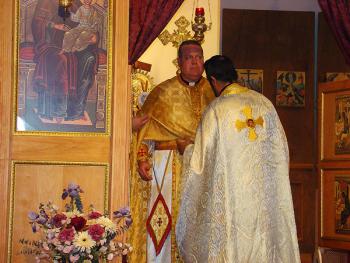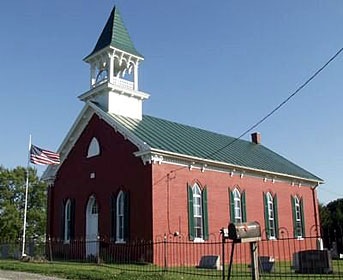One man's story, wrapped in tricky facts
 Let me begin by expressing my deepest and most sincere sympathies for reporter Ron Cassie of The Frederick News-Post. It's one thing to be assigned a complicated feature story about a complicated subject -- the conversion of a minister in one Protestant tradition into the oh-so-complicated world of Eastern Orthodoxy. But it's something else to be handed a story as confusing as the journey of James K. Hamrick and his flock.
Let me begin by expressing my deepest and most sincere sympathies for reporter Ron Cassie of The Frederick News-Post. It's one thing to be assigned a complicated feature story about a complicated subject -- the conversion of a minister in one Protestant tradition into the oh-so-complicated world of Eastern Orthodoxy. But it's something else to be handed a story as confusing as the journey of James K. Hamrick and his flock.
So let me start by saying that Cassie gets one big thing right -- by allowing Hamrick the time and space to explain his decision. The problems in this story are almost all technical and historical. Let's face it: This is complex stuff. Here's the lede:
Last weekend, at a service at St. Basil the Great Orthodox Church in Poquoson, Va., Bishop Thomas Joseph ordained James K. Hamrick into the holy priesthood of the Western Rite Orthodox Church.
It was a moment Hamrick's congregation in Lewistown has been waiting for since early spring. On April 10, his small flock at the former Charismatic Episcopal Lamb of God Church converted en masse to the Antiochian Orthodox faith, which includes both Western Rite and Eastern Orthodox churches.
The problem is that the Western Rite Orthodox Church does not exist. Instead, the Antiochian Orthodox Christian Archdiocese of North America has a small Western Rite ministry or branch. Click here for more information on the history of that.
Note that this story also had to deal with complex issues linked to recent divisions within the Charismatic Episcopal Church -- as opposed to charismatic congregations within the Episcopal Church. Or, wait, are we actually dealing with the International Communion of the Charismatic Episcopal Church? See what I mean? These kinds of problems cannot be avoided. Here's another example:
After preparation, members went through the sacramental rite of chrismation into the Antiochian Orthodox faith. Further highlighting their transformation, the congregation adopted a new name: St. John the Baptist Orthodox Church.
This weekend, Hamrick will lead an Orthodox Sunday Mass for the first time at the church, marking the final step for the 45-year-old priest and his congregation as Maryland's first Western Rite Orthodox church.
Actually, they were simply chrismated into Orthodoxy -- period. I also need to ask someone in the Western Rite movement: Is the proper term "Mass," or "Divine Liturgy," as in the Eastern tradition?
Hamrick's own story is told in very simple terms, even though it is quite complex, as well. He was born into the family of a United Methodist pastor, but pursued a career in law enforcement. In fact, as a bi-vocational priest, he still serves as assistant chief of police at the University of Maryland. This must create some interesting wardrobe issues.
Working weekdays in College Park and leading weekend services near his home in Thurmont, Hamrick is called a "bi-vocational" in the religious community.
"Other people sometimes call me 'the pistol-packing priest,' " he said, with a laugh.
Handling the demands of both jobs, and what could be construed as inherent conflicts -- the image of a peaceful nonviolent minister versus a policeman who may be required to deadly force -- has never been an issue, Hamrick said.
"I see a lot of similarities, actually, in the two roles," he said. "There is a similar sacred trust. Being a police officer is not contrary to my thinking of Christ as the Good Shepherd."
But then the story has to head back to the complex issues of church history and government, in Orthodox and alternative Anglican environments. And what about Rome?
For practical reasons, he dismissed becoming a Roman Catholic priest. Being married didn't rule him out automatically -- previously married and ordained Christian ministers are sometimes admitted to Catholic seminaries -- but he thought, if nothing else, the process would take an unreasonably long time given his circumstances.
Hamrick finally realized his beliefs were in more in line with the Orthodox Church, which split from the Roman Catholic Church in 1054.
The key word there is "from" and you could assemble a football stadium full of church historians to argue whether Rome left the Eastern Church or the Eastern Church left Rome without coming to much clarity. For a glimpse of all of that, click here (West) and then here (East).
 Wait, there's more:
Wait, there's more:
Hamrick disagrees with the Roman Catholic concept of papal infallibility and universal jurisdiction of the pope; he prefers the somewhat less hierarchical Orthodox structure. He said, however, that he would like to see the Eastern Orthodox and Roman Catholic churches reunite.
The Orthodox are "less hierarchical"? Not really. You can say that the ancient Eastern Churches are not united around a single core hierarchy, but that does not ultimately make the system less hierarchical. I would assume that a fine detail of Hamrick's explanation was lost. But, hey, the story doesn't say that the Ecumenical Patriarch in Istanbul is the "Orthodox pope." That's a start.
As a reader noted, while sending in the URL for this report, it would have been good to have known if any parishioners did not want to make this move and stayed with the CEC and its blending of Protestant and Catholic streams of faith. I also wondered if the reporter was actually present at the service, since Bishop Thomas is not quoted. We also needed at least one sentence explaining the Eastern Rite, in order to help readers understand the unique history of the Liturgy of St. Gregory -- which is a truly ancient Western rite.
But, as you can tell, I am trying to express sympathy for the task faced by this reporter. The key is that this new priest got to tell his story -- which is surrounded by details so complex that I am sure that I have left a few things out that should be mentioned. The religion beat is complicated, folks.
Photos: From the website of the Antiochian Orthodox Christian Archdiocese of North America.